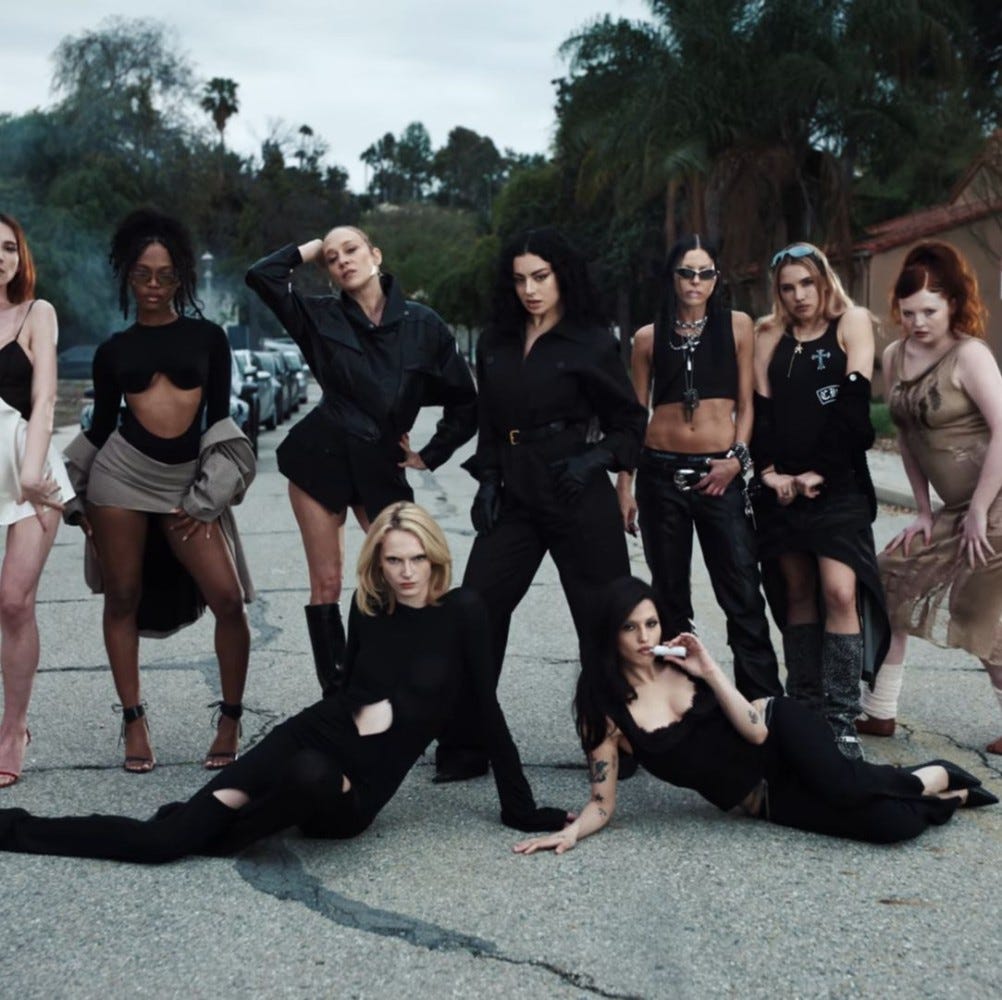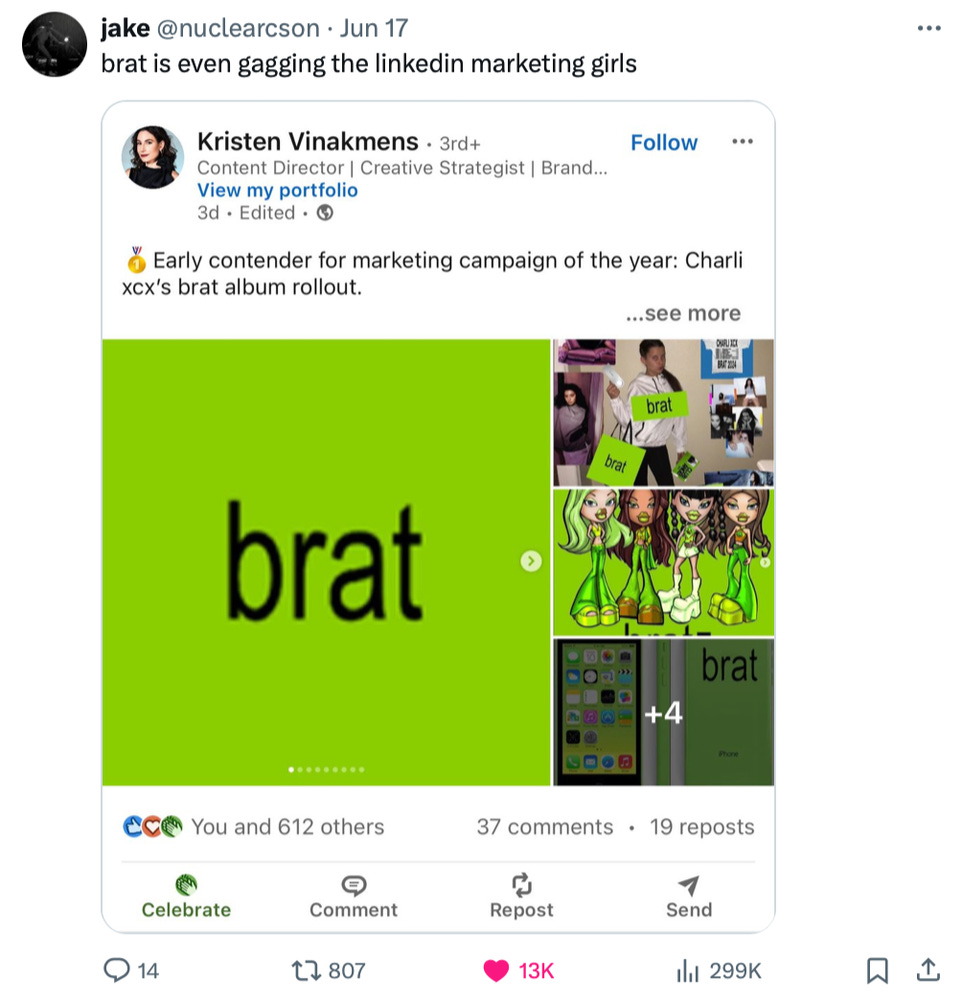I’ll begin this by saying I am a huge Charli XCX stan and have been since my days in 2014 scrolling Tumblr for hours. Naturally, with the advent of her latest critically acclaimed album brat, the equally acclaimed deluxe album, Charli has taken over the internet by a neon-green storm. What struck me was the incredible success she had in the rollout of this album. Beyond being a fan, even the most neutral of users could sense the immense success. The rollout for brat should be celebrated for its ability to tap into cultural niches so authentically and can teach us a lot about finding said niches authentically.
brat (stylised in all lowercase) was not just an album release, it was a masterfully branded campaign that was able to transcend multiple mediums and dominate the current cultural conversation. It mirrored current cultural attitudes and behaviours, and most importantly reflected the ‘culture’ (or perhaps more accurately, challenged culture). It was intentional, the name and theme had an infectious, almost aspirational energy. The branding is so replicable and usable with an open toolkit - anyone can participate. This style and its offshoots have been inescapable. It begs for participation. It also launched by leveraging the cultural capital of Boiler Room, allowing it to anchor it in the moment with known reach. It makes people across generations and scenes want to engage and gives this creative class the tools to engage.
Don’t worry, this isn’t an album review per se. There’s countless across the internet, cementing the album as one of the most critically acclaimed on Metacritic. Instead, I’d like to discuss the reason for brat’s success, beyond just the music. As the brat campaign spreads across all corners of the internet (I mean from Grindr to Linkedin, she really is everywhere she’s so Julia), I want to discuss why the brat persona appeals to so many of us, and not to sound like a cringe Linkedin-fluencer, why it’s a case study in impeccable branding and cultural understanding. Months in the making, the web-breaking rollout included a Charli-led army of internet ‘it’-girls for her 360 music video, which tapped into the current cultural influences beyond the standard. Julia Fox, Hari Nef, Alex Consani, even enlisting Chloë Sevigny and Emma Chamberlain, are all known and loved for their own brand of authenticity. There was also the viral spread of a sickly shade of green, first maligned but then wildly beloved and reproduced, becoming immediately ‘memed’ across all platforms and instantly recognisable (and available through the bratgenerator). There was even a Brat-green car branded the ‘Brat mobile’ racing its way through key cities. The list goes on, it was inescapable yet authentic, it was everywhere yet felt so real.
There’s a reason it felt so real, and it’s because this aesthetic is what we so desperately want. Messy eyeliner, sticky dancefloors, red wine spilled on white tank-tops - it’s a direct departure from an overly curated, hyper-consumerist idea of fun we’ve been forced to adopt. The clean girl becomes the ‘365 party girl’, shamelessly brash yet vulnerable, the last one of the dancefloor who also contemplates life at 3am afters. We love it, it’s in tune with a growing desire for connection and authentic, nostalgic fun amidst a pandemic of loneliness across the world. We don't want perfect idols, we crave the beauty in imperfection and getting together authentically, which is what this album and campaign roll-out emulates. It's a case study for brands wishing to engage with their audience - perfection isn't always coveted, it's more about understanding aesthetics and ways of life in culture.
It’s “this aesthetic… what we so desperately want. Messy eyeliner, sticky dancefloors, red wine spilled on white tank-tops - it’s a direct departure from an overly curated, hyper-consumerist idea of fun we’ve been forced to adopt.”
Charli also authentically showed up in spaces (and has across her career) during her roll out. From the Lot Radio in Brooklyn to nightclubs across London, Charli engaged with her fans in exclusive spaces for her ‘brats, her fanbase who she’s loyally been devoted to. It tapped into the idea of fan culture and community - not showing up for the sake of it, but for your fans to have fun. It allowed her fans to feel a part of the moment. She showed up in niche spaces, yet they still 'made sense.' It's a testament to a desire to be together in real life; As Grace Gordon writes for the Sociology of Business, “She promoted her album the same way a Brooklyn dj would their latest mixtape. She didn’t go straight to mass media, nor did she operate from a space of rarified air, perfection or mystique.” This also serves as an example for brands that showing up in the physical space if essential for connecting authentically with an audience. Experiential marketing is important in a hyper-online world, and helps push above the noise.
While not all brands will have the cultural capital of Charli XCX (and nor should they, brands shouldn’t be the ones driving culture, they should support it). Authenticity is key. Brands should focus on facilitating community rather than trying to build it from scratch. Providing simple tools or experiences and letting the audience do the rest can lead to more genuine and engaging outcomes. The simpler and more accessible the brand codes, the greater the participation and expression from the community.
It’s not lost on me that other pop artists have attempted to replicate this shift, often in a shitty, disingenuous way. The ‘alt-girl’ image is suddenly commodifiable and commercially successful, and we’re seeing artists like Camila Cabello and Katy Perry quite shamelessly attempt to rebrand themselves after pioneers like Charli, alongside her alternative peers like Arca and the late SOPHIE. It’s clear that authenticity and imperfection is in. And who better to deliver than the party girl herself, who across her expansive career has ingrained herself with a loyal fanbase, celebrated her expansive LGBTQ+ following, and has always authentically stayed true to herself, her sound, and her aesthetic. A lot of brands fall for this as well, attempting to perfectly recreate rather than authentically engage.
Equally importantly, brat and its rollout prioritised IRL fun, paying homage to the club it was born from. The rollout was equally online (a continuous feed of online content for fans everywhere in the lead up), as well as remixes in clubs, intentional leaks, and an overall celebration of the joy and play when getting together IRL in spaces meant for dancing and connection (I mean her Boiler Room set looked straight out of 90s rave culture, just add in a few hundred phones clamouring to get a snippet).
Fan culture, club culture, meme culture, and authentically capturing the cultural zeitgeist catapulted the album into critical acclaim. And while I may have elaborated too much as a fan, it’s a perfect example of hard work and dedication to a cultural niche paying off in dividends. And it feels especially prominent in comparison to crude copycats hoping to hop in on the culture. It doesn’t work like that, and brat can teach that for brands. Engage with your culture, but don’t try to take it over. Culture is driven by people, brands can help facilitate this community, but not without authentic engagement. Don’t just show up to show up, show up because you care about your audience. Charli cared about her niche fanbase, so everything post-brat feels right and honest, and exquisitely executed. And for brands with supposedly less glamorous products, the same thought remains - if you develop a POV and build for people who get it, and stay authentically true to them, then cultural success will follow.







